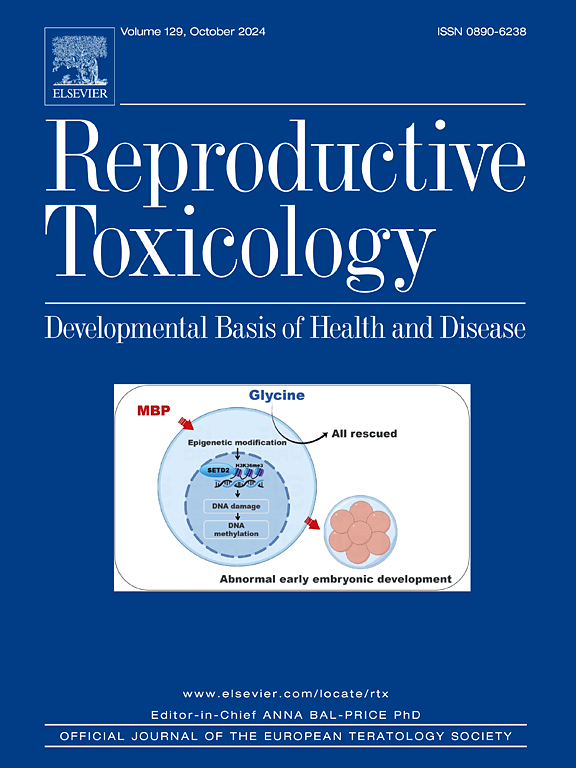The consumption of monosodium glutamate during the periconceptional period can impair preimplantation embryo development
IF 2.8
4区 医学
Q2 REPRODUCTIVE BIOLOGY
引用次数: 0
Abstract
Monosodium glutamate (MSG) is one of the most commonly used food additives and is consumed worldwide as part of commercially processed foods. To study the possible reproductive risks of consuming monosodium glutamate during the periconceptional period (comprising oocyte maturation and the earliest stages of embryo development), we administered MSG (at doses of 500, 200 or 50 mg/kg body weight, by oral gavage) to female mice in this period. Preimplantation embryos were then isolated at D4 of gestation and analyzed. In blastocysts developed from female mice fed with MSG, we found a reduced proportion of blastocysts, a lower number of cells, and an increased proportion of dead cells. The expression of the proapoptotic gene Bak1 and active caspase-3 were significantly increased and telomeres were shorter in blastocysts isolated from MSG-fed females. The results of our previous in vitro study revealed that glutamate receptors are involved in the negative effects of glutamate on mouse blastocysts. In silico analysis of RNA-seq datasets containing data from human preimplantation embryos performed in this study revealed that NMDA receptors (formed from the GRIN2D or GRIN2B and GRIN3B subunits) and the GRM4 and GRM8 metabotropic receptors are expressed in human blastocysts. These results indicate that glutamate receptors could mediate the effects of MSG in human blastocyst cells. In summary, our results show that oral intake of relatively low doses of MSG during the periconception period can adversely affect early embryonic development and embryo quality and may pose a risk to successful conception and subsequent embryo development.
妊娠期谷氨酸钠的摄入会影响着床前胚胎的发育
味精(MSG)是最常用的食品添加剂之一,作为商业加工食品的一部分在世界范围内消费。为了研究在妊娠期(包括卵母细胞成熟和胚胎发育的早期阶段)摄入味精可能的生殖风险,我们在这一时期给雌性小鼠注射味精(剂量为500、200或50 mg/kg体重,通过口服灌胃)。在妊娠第4期分离着床前胚胎进行分析。在喂食味精的雌性小鼠发育的囊胚中,我们发现囊胚比例减少,细胞数量减少,死亡细胞比例增加。msg喂养的雌性胚泡中,促凋亡基因Bak1和活性caspase-3的表达显著升高,端粒缩短。我们之前的体外研究结果表明,谷氨酸受体参与了谷氨酸对小鼠囊胚的负面影响。本研究中对包含人类着床前胚胎数据的RNA-seq数据集进行的计算机分析显示,NMDA受体(由GRIN2D或GRIN2B和GRIN3B亚基形成)以及GRM4和GRM8代谢受体在人囊胚中表达。这些结果表明,谷氨酸受体可以介导味精在人胚泡细胞中的作用。综上所述,我们的研究结果表明,围孕期口服相对低剂量的味精会对早期胚胎发育和胚胎质量产生不利影响,并可能对成功受孕和随后的胚胎发育构成风险。
本文章由计算机程序翻译,如有差异,请以英文原文为准。
求助全文
约1分钟内获得全文
求助全文
来源期刊

Reproductive toxicology
生物-毒理学
CiteScore
6.50
自引率
3.00%
发文量
131
审稿时长
45 days
期刊介绍:
Drawing from a large number of disciplines, Reproductive Toxicology publishes timely, original research on the influence of chemical and physical agents on reproduction. Written by and for obstetricians, pediatricians, embryologists, teratologists, geneticists, toxicologists, andrologists, and others interested in detecting potential reproductive hazards, the journal is a forum for communication among researchers and practitioners. Articles focus on the application of in vitro, animal and clinical research to the practice of clinical medicine.
All aspects of reproduction are within the scope of Reproductive Toxicology, including the formation and maturation of male and female gametes, sexual function, the events surrounding the fusion of gametes and the development of the fertilized ovum, nourishment and transport of the conceptus within the genital tract, implantation, embryogenesis, intrauterine growth, placentation and placental function, parturition, lactation and neonatal survival. Adverse reproductive effects in males will be considered as significant as adverse effects occurring in females. To provide a balanced presentation of approaches, equal emphasis will be given to clinical and animal or in vitro work. Typical end points that will be studied by contributors include infertility, sexual dysfunction, spontaneous abortion, malformations, abnormal histogenesis, stillbirth, intrauterine growth retardation, prematurity, behavioral abnormalities, and perinatal mortality.
 求助内容:
求助内容: 应助结果提醒方式:
应助结果提醒方式:


